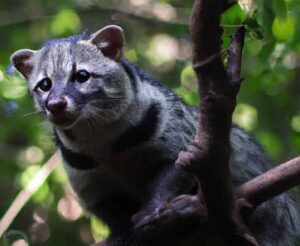PRELIMS BITS
Context:
A rare Small Indian Civet was spotted near Tadepalli in Guntur district, Andhra Pradesh, a region where it is not commonly seen.
About Civet Cats:
- Classification: Not true cats; belong to the family Viverridae, closely related to mongooses.
- Diversity: 15–20 species worldwide.
- Distribution: Found in Asia, Africa, and Southern Europe; common in India, Sri Lanka, Southeast Asia, and sub-Saharan Africa.
- Habitat: Tropical forests, grasslands, and human settlements.
- Physical Traits:
- Thick furred tail, small ears, and pointed snout.
- Colors vary, often buff or greyish with black spots or stripes.
- Diet: Omnivorous – consumes fruits, small mammals, insects, and coffee cherries.
- Threats: Habitat loss, hunting, and commercial exploitation for their musky scent, used in perfumes.
Civets in India:
India is home to 8 species of wild civets, with varying conservation statuses.

| Civet Species | Key Features | IUCN StatusLeast Concern | WPA (1972) Schedule |
| Malabar Civet | Endemic to Western Ghats. | Critically Endangered | Schedule I |
| Binturong | Largest civet in India. | Vulnerable | Schedule I |
| Large Indian Civet | Distinctive dark stripe with white bands. | Not Listed | |
| Small Toothed Palm Civet | Known as Three Stripe Palm Civet. | Least Concern
|
Not Listed |
| Masked Palm Civet (Himalayan Palm Civet) | Found in the Himalayas & Northeast India. | Least Concern | Not Listed |
| Brown Palm Civet | Endemic to Western Ghats. | Least Concern | Not Listed |
| Common Palm Civet | Found across India. | Least Conc
ern |
Not Listed |
| Small Indian Civet | Widely distributed in the subcontinent. | Least Concern | Not Listed |
Conservation Concerns:
- Malabar Civet is Critically Endangered due to habitat destruction.
- Binturong and other civets face threats from poaching, deforestation, and illegal wildlife trade.
- Conservation efforts are needed to protect their habitats and populations.




